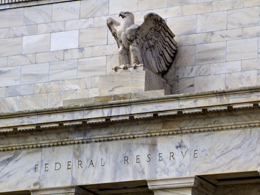 The big news in my house right now is Halloween, with a major costume decision between Toothless (a dragon) and Hiccup (his friend) hanging in the balance. Neither choice is particularly scary (it’s a small dragon), and that’s okay—it won’t be a very scary Halloween for the economy either.
The big news in my house right now is Halloween, with a major costume decision between Toothless (a dragon) and Hiccup (his friend) hanging in the balance. Neither choice is particularly scary (it’s a small dragon), and that’s okay—it won’t be a very scary Halloween for the economy either.
The Federal Reserve certainly sent that message yesterday, as it announced its decision to stop buying bonds. With the end of the bond-buying program, known as quantitative easing or QE, the Fed has begun to step back from directly supporting the economy for the first time in years.
Well, maybe a little scary
With the Fed out of the market (but continuing its low rate policy), it’s sort of like going trick-or-treating on your own for the first time. Even though we know Mom is still keeping an eye on us, the lack of hand-holding is a bit unsettling. I think that explains the market’s reaction yesterday and today.
Mom believes in us, though. The Fed’s statement was, in my opinion, surprisingly hawkish, reflecting an increasing conviction that the economic recovery is real. From the “substantial improvement in the outlook for the labor market” to the “sufficient underlying strength in the broader economy to support continued progress,” the statement conveyed the Fed's belief that the recovery is well founded and even starting to accelerate.
Other language suggested that the Fed is now shifting from worrying most about employment to worrying more about inflation. But even there, it doesn't seem particularly concerned. Despite a drop in inflation due to lower oil prices and a stronger dollar, the Fed reported that the likelihood of inflation being too low has actually decreased this year.
Overall, it sounds like the Fed is well on its way to pulling back entirely.
What about the specter of rising rates?
While the phrase “a considerable time” remained, it was immediately qualified with the statement that rates would rise faster or slower if necessary—but faster came first. I read this as a warning shot that the Fed expects the economy to continue to improve, and that rates will be going up. Even if we interpret “considerable time” to mean the six months Janet Yellen previously indicated, that brings us to about next May, making either March or June quite possible.
Meanwhile, the economic data released this morning suggests things are improving:
- Third-quarter economic growth came in at 3.5 percent, well above expectations of 3 percent.
- Initial jobless claims continued under 300,000, the lowest level since early 2006 (and before that, 2000)—boom times, if you remember.
While there's more to these figures, the clear trend is up—and at an increasing rate.
It now appears more and more likely that the economy is accelerating and that, barring some external surprise, the Fed will be tightening faster than most expect. This is actually a good thing; rising rates, accompanied by a recovering economy, haven’t been a problem historically.
I took the Fed statement yesterday as one more endorsement of the recovery, from a very skeptical audience. I hope they turn out to be right.



 Print
Print

